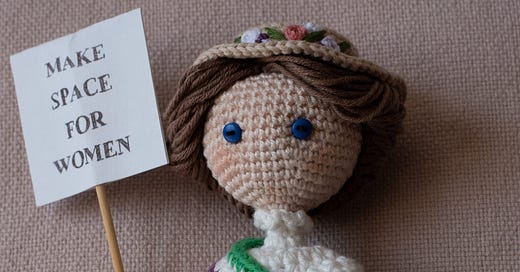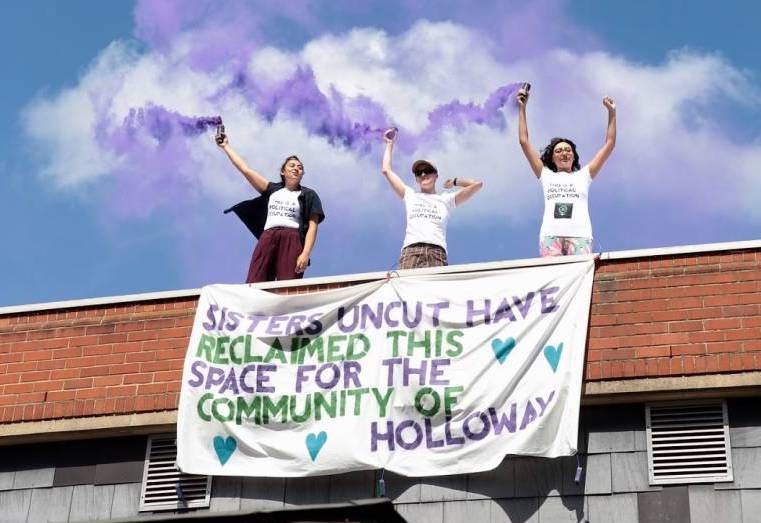It's a Women's Centre on the site of a women's prison. Why would we let women design it?
Plus flash floods and unexploded bombs
Ask someone to name a former inmate of Holloway Prison and you’ll likely get the answer ‘Oscar Wilde’.
The answer’s not wrong (Wilde was on remand there) but it’s a bit strange nonetheless, because Holloway prison was only a mixed-sex prison for the first fifty of its 164 years. After 1903 Holloway became a female-only prison and it stayed that way until it closed in 2016.
In that time notable inmates included Emmeline Pankhurst, Emily Davison, Diana Mitford (who lived in a cottage in the prison grounds with her husband, Oswald Mosley), Myra Hindley and Joyce ‘Manacled Mormon’ McKinney .
After the prison shut its doors for the last time, the plan was to sell the land for housing. That took three years, but in 2019 the site was finally sold to the Peabody housing association, with the help of a £42 million loan from the Mayor’s Land Fund.
Peabody’s plans were genuinely ambitious:
“Peabody is fully committed to an inclusive and wide-reaching community engagement programme… with their architects, AHMM [they] will work with a wide range of local resident and community groups to discuss how best to deliver an exceptional new place for Holloway. Ensuring this unique site provides the right type of homes, public spaces and community amenities for local people. “
We’ve seen developer promises like that before of course, but this time Islington Council’s planning guidance for the project stipulated that the site must contain 60% genuinely affordable housing, green spaces, and a Women’s Centre.
Holloway reclaimed? Not quite
This hadn’t all come about purely by chance. It was largely down to the hard work of Reclaim Holloway, a coalition of groups and local people who had come together to push for social housing and community spaces to be built on the site, with a special focus on the Women’s Centre which they hoped would “serve as a testament to those who were jailed, and those who worked, behind its forbidding walls.”
Even after the developers promised to meet their hard-won demands, Reclaim Holloway kept the pressure on. They created their own vision of what the Holloway Women’s Building should be (“something truly transformative, visionary, and entrepreneurial…to support women and their families, to help them through difficult times and provide practical assistance in rebuilding their lives); as well as how it should be designed and built (“The building should be open and light, the opposite of the old Prison…built with a well-informed environmental and sociological considerations in mind.”)
One idea was that design of the building should be put out to competition to women architects. This, you won’t be surprised to know, did not happen.
Less of a Women’s Centre. More of a Women’s Annex.
A few weeks ago more details on Peabody’s plans for the site started to come out and the campaigners (along with the architects, artists, women’s organisations, charities, academics etc they’d been working with) were told that the ‘landmark legacy’ they’d been working towards had been relegated to “a single floor under a residential block”.
At last month’s London Festival of Architecture women from across the industry had the opportunity to speak out on the plans. Here’s just a sample of what they had to say:
“A totally lost opportunity…. Dismissive, arrogant, and patronising.”- Helen Aston, Senior Lecturer at the Manchester School of Architecture.
“We should really be pressing for real facilities for women across London and even nationally. We just won’t accept anything else.” - Professor Linda Clarke from University of Westminster.
“It seems to me to be another marginalisation of women’s needs but also of women in the construction and the procurement processes.” - Sarah Akigbogun, from Women in Architecture.
“It’s very problematic, the way this whole project and the process has been conducted… In the end the money talks and the community is not really listened to and I feel it’s all round the wrong way.” - Sarah Wigglesworth of Sarah Wigglesworth Architects.
“Build the infrastructure to get women on those projects, and to stay in these jobs. And let women build the Women's Building!” - Dr Susan Moir, founder of Tradeswomen Building Bridges.
‘Community engagement’ or ‘Hurtful tokenism’?
This week more details of the scheme have been unveiled as a final round of public consultation happens ahead of a planning application to be submitted in November.
But after six years of hard campaigning, should the future of a space like this come down to a free text field in an online form?
Christine Murray, editor-in-chief at The Developer, said at the LFA that the public consultation “celebrates this idea of the Women’s Building, but it doesn’t seem very truthful to what they’re actually proposing to do,” and dismissed it as “tokenism” that “could actually be quite hurtful to everyone who is involved.”
Yesterday, as we sat down to start writing this issue, it was revealed that a fifth of Tory party donations come from the property sector, so it seems more important than ever that this kind of thing doesn’t just get written about in the pages of industry journals.
After all, these are the people who decide how London grows and how it evolves. They control who gets to use what space and what that space looks and feels like. And (in this case) what will be built on land bought using public money.
If you want to know more about what’s happening with the Holloway project and the campaign for the Women’s Centre you can follow Reclaim Holloway here. There’s also the Community Plan for Holloway (“an independent campaign working to ensure the Islington community is at the heart of the redevelopment of Holloway prison”) which has information on how to respond to the consultation.


And the rest…
Just as everyone starts commuting back to the office again it’s been announced that the City branch of the Northern Line will stop running for four months from 15 January 2022, in order to “facilitate complex final stages of work” on Bank station.
If you were anywhere near London Bridge on Monday you may have seen a big police presence. It turned out to be due to an unexploded World War II bomb in the courtyard of Guy’s Hospital. “The issue has been dealt with” apparently.
Some more promising housing news: Sadiq Khan, has announced a Right to Buy-back fund which will “give boroughs the funds to purchase former council homes that have been sold into the private market” (four in ten of which are just rented on the private market) “that will then be let at social rent levels or used as accommodation for homeless families.”
The Guardian reports on letters that have been sent to migrant rough sleepers in London, threatening them with “eviction from emergency hotel accommodation” and forced removal from the country.
It was reported this week that, over the past 12 months, “motorists have paid 250,000 fines worth £14m” for driving in LTNs. Hackney alone “has collected a staggering £2.7m, with 82% of those fined coming from outside the borough.”
The flash floods that happened at the start of the week turned Barnes Green into a swimming pool….
 Barnes Green has become a swimming pool. No literally. #beachlife #rain #londonweather @BCA4Barnes @richmondtimes @bbcweather @itvlondon @standardnews (a credit would be nice) ☔️🏊♂️
Barnes Green has become a swimming pool. No literally. #beachlife #rain #londonweather @BCA4Barnes @richmondtimes @bbcweather @itvlondon @standardnews (a credit would be nice) ☔️🏊♂️… and Sloane Square station into a water feature.








